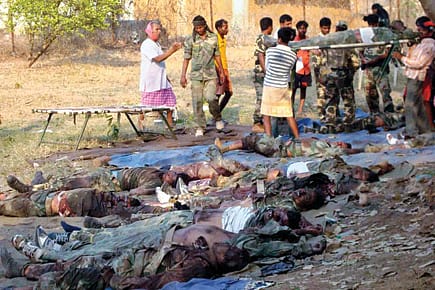The Men the Government Sacrifices

Sending ill-prepared soldiers to tackle Naxals is like throwing men into rivers as sacrifices to appease gods.
Sending ill-prepared soldiers to tackle Naxals is like throwing men into rivers as sacrifices to appease gods.
In ancient times, in order to appease an angry river, a community would select a man to be offered as a sacrifice to the river. He would be garlanded and then thrown into the foaming waters. In modern times, the same ritual is performed, albeit in a different manner. What else would you call those CRPF soldiers who lost their lives in one of the most audacious attacks by the Maoists of Dantewada? These men were offered as a sacrifice in a war that New Delhi has repeatedly failed to draw lessons from —one of them being that this war cannot be won by simply pushing battalions of ill-prepared men into a territory that they don't know at all. It's just that in our times, these men are garlanded after they have been killed—at the altar of State sovereignty.
Such attacks, as the Maoist leaders would tell you, are part of their psychological warfare to send out a clear message: not only do Maoists have the capacity to kill and maim through improvised explosive devices, they can also launch attacks that resemble conventional warfare, involving well-trained Maoist guerillas on the ground equipped with superior firepower. The Dantewada attack, which involved more than 1,000 heavily armed men and women guerillas, also marks a shift from guerilla warfare to mobile warfare, which is the second phase of the Maoists' protracted war. Mobile warfare basically aims at launching major attacks against the State forces and inflicting heavy damage. On the same day, Maoists were able to score another psychological victory by sending a fax to news agency PTI that their senior leader Kishenji had escaped unhurt in a recent attack in the Jangalmahal area near Lalgarh. So, while the attack has left the security forces frightened and demoralised, it has upped the morale of the Maoist cadres reeling under the recent arrests and killings of senior leaders.
2025 In Review
12 Dec 2025 - Vol 04 | Issue 51
Words and scenes in retrospect
The question is why sending paramilitary forces in large numbers to Chhattisgarh and other Naxal-affected areas won't work. Simply because in these areas, there is no clear enemy in sight. The soldiers, brought from other regions, have absolutely no idea about the topography of these areas. They are not trained in jungle warfare, save perhaps a crash course. The Centre should realise that simply making them run in jungles without water or teaching them how to catch snakes is not enough. Even if the Centre wants to tackle this issue militarily, it has to be done through precise operations that depend heavily on accurate intelligence inputs. The security top brass has repeatedly admitted that they have no proper intelligence-gathering apparatus in these areas. In less than two months, there will be the onset of monsoon, and after that, it will be nearly impossible to operate in these areas. I have seen this myself in Lalgarh last year, where paramilitary and other soldiers had no idea of what was expected of them. In the absence of basic facilities like proper barracks or safe drinking water, scores of them became victims of sunstroke, dehydration, and diarrhoea and malaria. In 2008-09, more than 100 policemen died of malaria in Jharkhand alone. With no clear enemy in sight, and in the absence of clear guidelines, most of the paramilitary forces ended up guarding roads surrounded by dense jungles on both sides. One CRPF soldier fainted in front of our car, and after we'd made him drink glucose water, he cried. In Chhattisgarh and other areas, such scenarios would be imaginable once it begins to rain. Maoists, on the other hand, are used to harsh jungle life, they know these areas like the back of their hands, and are better trained and motivated than the CRPF or other forces.
So, what should the Government do? To begin with, it should hear out one of its former ministers, the senior Congress leader Mani Shankar Aiyar. I had halted at a roadside eatery in Birpur, the village of Maoist supreme commander Ganapathi, in Andhra Pradesh's Karim Nagar district, when I heard Aiyar speaking in a TV debate. He made absolute sense when he said that social schemes such as the Rural Employment Guarantee scheme or Food Security Bill are not going to work unless we also work towards empowering local communities alongside. Those who have reported from mining areas know what a sham acts like PESA (Panchayats Extension to the Scheduled Areas) can turn out to be. On the day of the attack, I was in Nagpur, and Aiyar was once again on TV saying categorically that a military solution to the Naxal issue was not possible at all.
So, Chidambaram and his men may not pay heed to what reporters like myself or people he calls 'intellectual sympathisers' have been saying, but he could take out time to listen to his former cabinet colleague. Two cents hi sahi.
Rahul Pandita will be reporting from the Naxal heartland over the next few weeks.
